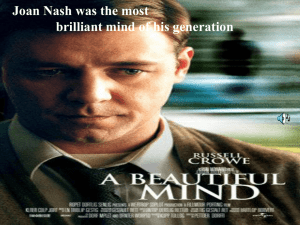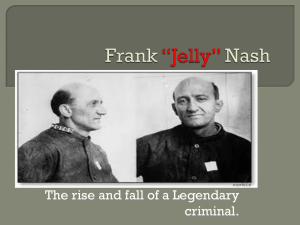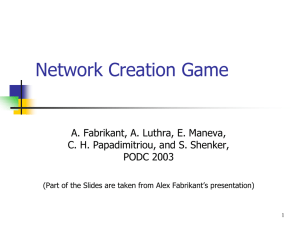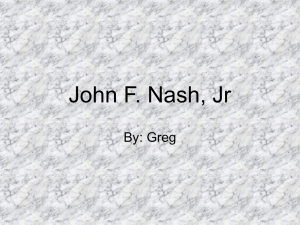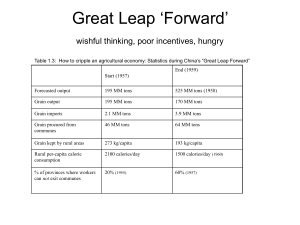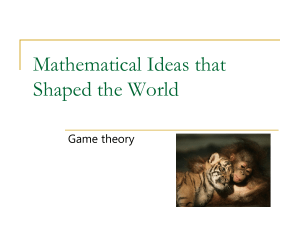A Beautiful Mind
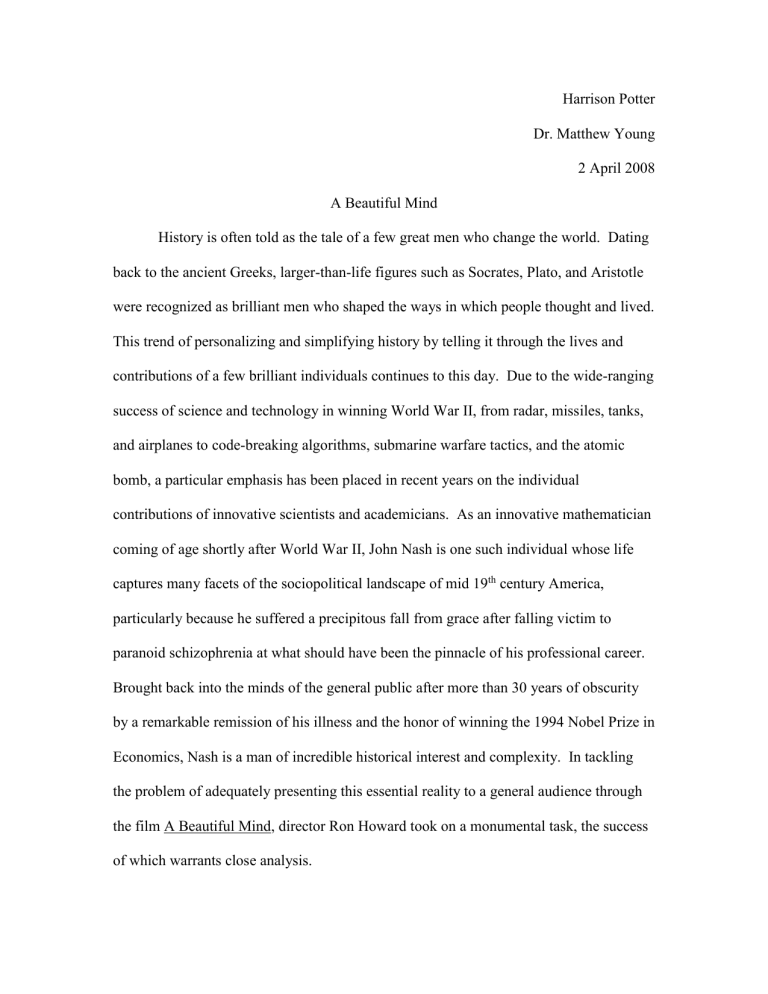
Harrison Potter
Dr. Matthew Young
2 April 2008
A Beautiful Mind
History is often told as the tale of a few great men who change the world. Dating back to the ancient Greeks, larger-than-life figures such as Socrates, Plato, and Aristotle were recognized as brilliant men who shaped the ways in which people thought and lived.
This trend of personalizing and simplifying history by telling it through the lives and contributions of a few brilliant individuals continues to this day. Due to the wide-ranging success of science and technology in winning World War II, from radar, missiles, tanks, and airplanes to code-breaking algorithms, submarine warfare tactics, and the atomic bomb, a particular emphasis has been placed in recent years on the individual contributions of innovative scientists and academicians. As an innovative mathematician coming of age shortly after World War II, John Nash is one such individual whose life captures many facets of the sociopolitical landscape of mid 19 th
century America, particularly because he suffered a precipitous fall from grace after falling victim to paranoid schizophrenia at what should have been the pinnacle of his professional career.
Brought back into the minds of the general public after more than 30 years of obscurity by a remarkable remission of his illness and the honor of winning the 1994 Nobel Prize in
Economics, Nash is a man of incredible historical interest and complexity. In tackling the problem of adequately presenting this essential reality to a general audience through the film A Beautiful Mind, director Ron Howard took on a monumental task, the success of which warrants close analysis.
Potter 2
In many ways the film A Beautiful Mind completely betrays the fidelity of historical detail in its portrayal of the life of John Nash. Although he did enroll as a graduate student at Princeton University in the fall of 1948, his experience there was markedly different from that portrayed in the film. In the opening scene, Professor
Helinger delivers a motivational speech to the incoming freshman class, including Nash, asking the students “Now who among you will be the next Morse? The next Einstein?
Who among you will be the vanguard of democracy, freedom, and discovery?” This speech sets the tone for the time Nash spends at Princeton, making it clear that he is expected to deliver “publishable, applicable results” in order to earn his keep. This is very much in line with the competitive, cut-throat atmosphere established in reality by
Professor Solomon Lefschetz, who actually delivered a similar, though much stronger, speech welcoming Nash to Princeton, which served as the inspiration for the one delivered by Professor Helinger in the film. How various aspects of student performances were taken into account in evaluating a student’s performance, however, are completely distorted in the film. The film makes it clear that students are expected to attend class, for example, by having Nash respond to an inquiry by Sol, a fellow graduate student, regarding why he has been skipping classes by saying “Classes will dull your mind, destroy the potential for authentic creativity.” Professor Helinger also holds Nash accountable for his class absences later when Nash is seeking a continuation of his financial support. Professor Lefschetz, however, made it clear on the very first day in no uncertain terms that “They could go to class or not go to class. He didn’t give a damn.
Grades meant nothing. They were only recorded to please the ‘goddamn deans.’ Only the generals counted. There was only one requirement: come to tea. They were absolutely
Potter 3 required to come to tea every afternoon. Where else would they meet the finest mathematicians in the world?” (Nasar 59).
Such a depiction of life as a graduate student at Princeton in 1948 is clearly distinct from that portrayed on film, at least in the details. In a broader sense, however, the film does effectively communicate that Princeton was dominated at the time by a completely unforgiving atmosphere. “If the faculty, which got to know every student well, decided that so-and-so wasn’t going to make it, Professor Lefschetz wasn’t shy about not renewing the student’s support or simply telling him to leave” (Nasar 60). This point is emphasized in a series of dramatic scenes in the film, though again with halftruths carefully woven in with historically accurate material. Nash, nearing the end of his first semester, runs into trouble with Professor Helinger when he does not attend class or publish any research papers. Helinger makes it very clear that Nash is in serious academic trouble, stating impatiently “John, your fellows have attended classes, they’ve written papers, they’re published… You haven’t focused. Now I’m sorry, but up to this point your record doesn’t warrant any placement at all. Good day.” Although this serves as an accurate reflection of Lefschetz’s policy of intolerance regarding underachieving students, this scene inaccurately depicts John as a struggling and troublesome student.
Nothing could have been further form the truth. “Princeton’s approach to its graduate students, with its combination of complete freedom and relentless pressure to produce, could not have been better suited to someone of Nash’s temperament and style as a mathematician, nor more happily designed to elicit the first real proofs of his genius”
(Nasar 61). The real John Nash took only 2 years to obtain a doctorate degree in mathematics from a premier institution, something that typically takes a student 4 to 6
Potter 4 years to achieve. Although in the spring of 1949 Professor Emil Artin, a distinguished algebraist at Princeton, was opposed to renewing Nash’s fellowship, his objections were founded on a personal bias against the peculiar way in which Nash conducted himself rather than on any lack of scholarly ability. Accordingly, Professors Lefschetz, Norman
Steenrod, and Albert Tucker, who would later serve as Nash’s thesis advisor, overruled
Artin’s objections and granted Nash an Atomic Energy Commission fellowship for the following academic year (Nasar 73-4).
In spite of all of his success, however, an inherent insecurity did dominate his personality and lifestyle. “His expression was somewhat haughty and he smiled to himself in a superior way…He seemed eager to be noticed and seemed to want to establish that he was smarter than anyone else in the place…He seized opportunities to boast about his accomplishments…He was a self-declared free thinker… He implied that his lineage was superior to that of his fellow students, especially Jewish students” (Nasar
67). A guiding principle in John Nash’s life was that he was a class above other humans, and that, as a result, everyone should recognize his superiority and praise him for it.
When this did not occur, or when doubt was shed on this alleged fact, he groped for a sense of self-worth and confidence in who he was. These truths are communicated in the film by weaving them into the very same scenes that establish Princeton as a highly competitive academic environment. Although in reality these are two related but distinct undercurrents in Nash’s life that later played a role in triggering the onset of his paranoid schizophrenia, these two themes are all but indistinguishable in the film.
A particularly revealing and crucial scene early in the film is that in which Nash and his roommate Charles, who is in fact merely a delusion, are having a conversation on
Potter 5 the roof of the dormitory. Nash, essentially speaking to himself, engages in monologue, saying “Despite my privileged upbringing, I’m actually quite well-balanced: I have a chip on both shoulders… My first grade teacher told me that I was born with two helpings of brain but only half a helping of heart... The truth is that I don’t like people much, and they don’t like me… Do you know half these schoolboys are already published? I cannot waste time with these classes and these books, memorizing the weak assumptions of LESSER MORTALS. I need to look through to the governing dynamics, find a truly original idea. That’s the only way I’ll ever distinguish myself, that’s the only way that
I’ll ever…” at which point Charles completes his sentence with “…matter,” a conclusion with which Nash expresses his agreement.
Soon thereafter, these sentiments are emphasized by a scene in which Martin
Hansen, a brilliant student whom Nash views as a rival and threat to his intellectual dominance, challenges Nash to a game of go, one of many games that truly were popular among Nash and his colleagues (Nasar 75-8). During the game they engage in conversation. “What if you never come up with your original idea,” Hansen asks Nash,
“how will it feel when I am chosen for Wheeler and you are not? What if you lose?”
Upon finishing his rhetorical question, Hansen makes a decisive move in the game that secures his victory over Nash, sending Nash careening away, mortified over his inability to cope with his own potential for failure. Later, after being threatened with expulsion by
Professor Helinger for underperforming, Nash is emotionally overwhelmed in his room in a scene with Charles, rambling with panic. “I can’t see it... I can’t see it. This is all I am… I’ve got to get something done… I can’t keep staring into space… I gotta sit in here, I gotta face the wall, follow their rules, read their books, go to their classes…”
Potter 6
Charles, meanwhile, is trying to get John to calm down, pushing the desk back toward the window while John is pushing it towards the wall, leading John to finally erupt with
“God damn it, Charles, what is your problem?” to which Charles replies “It’s not my problem, and it’s not your problem. It’s their problem. Your answer isn’t ‘face the wall,’ it’s out there, where you’ve been looking.”
This sequence of scenes is incredibly revealing, communicating several vital aspects of Nash’s character quickly and effectively; however, although the essence of these scenes is rooted in historical truth, they cannot be taken at face value without distorting reality. In order to effectively use the medium of film to communicate the story of John Nash, the filmmakers had to use a significant amount of dialogue, omitting any potential scenes that would be devoid of action. Silent contemplation, however, characterized Nash as a person. “He was always buried in thought. He’d sit in the common room by himself. He could easily walk by you and not see you. He was always muttering to himself. Always whistling. Nash was always thinking” (Nasar 69). As presented onscreen, Nash was only somewhat asocial and arrogant, eventually coming to terms with his own insecurities through his loving relationship with Alicia. It is suggested that the pressures of being a graduate student at Princeton who desperately wanted to succeed and prove himself in such a harsh environment led to his highly critical attitude towards himself and others, as well as his lack of satisfaction with his own success.
Although this is a tempting way to view such a brilliant man, it is ultimately inaccurate: Nash was actually an incredibly insensitive, socially awkward, narcistic human being. Assertions that he lacked emotion and caring for other people are
Potter 7 particularly relevant to the central theme in the movie, namely that love can overcome any obstacle, even as crippling a mental illness as paranoid schizophrenia, but they hardly scratch the surface of the real John Nash. Regularly attacking his peers by dismissing their insights as “trivial” and accusing them of “burbling” and “hacking” their way through mathematical discussions, Nash was not well-liked, but rather merely tolerated due to his impressive intellectual insights and contributions (Nasar 67). In possession of a wry, childish sense of humor and a violent temper, he was also feared by many of his fellow students. “On one occasion, Nash was baiting one of Artin’s students by telling him that the best way into Artin’s graces was to catch his beautiful daughter Karin. The student, Serge Lang, who everyone knew was painfully obsessed by his shyness around girls, threw a hot cup of tea in Nash’s face. Nash chased him around the table, threw him to the ground, and stuffed ice cubes down the back of his shirt. Another time, Nash picked up a metal ashtray stand – the kind that supports a heavy glass ashtray – and brought it down on Melvin Peisakoff’s shins, hard enough to cause considerable pain for a number of weeks” (Nasar 73).
These were not isolated incidences, but are instead representative examples of his habit of projecting his self-doubt onto others through insults and of expressing his selfhate through violence. As an undergraduate at Carnegie Institute of Technology, the forerunner of Carnegie Mellon University, several fellow students filled his room with cigarette smoke while he was studying inside. This harmless prank was met with violent retaliation, as Paul Zweifel, one the students, recalls. “He came roaring out of his room, picked up Jack [Wachtman], and threw him down on the bed. He ripped off Wachtman’s shirt and bit him in the back. Then he ran out of the room” (Nasar 43). Following
Potter 8
Professor Helinger’s opening address in the film, the fact that Nash was socially peculiar and insensitive is demonstrated with his comment at the welcome reception to fellow student Ainsley that “There has to be a mathematical explanation for how bad your tie is” and his following attack on Hansen in which he asserts “I assume you've gotten quite used to miscalculation. I read your pre-prints, both of them. One on Nazi scientists, and the other one on non-linear equations, and I'm extremely confident that there's not one seminal or innovative idea in either one of them. Enjoy your punch.” While these scenes attempt to convey a sense of the social awkwardness that characterized Nash throughout his life, they do not take it nearly far enough to approach reality. When interacting with his peers, Nash took Princetonian arrogance to a whole new level.
This misrepresentation of Nash’s character cannot simply be ignored in analyzing the quality of the film as a historical piece because it is made overwhelmingly significant through his relationship with Alicia. Alicia is portrayed as a strong, aggressive woman who knows exactly what she wants and is getting into by courting John. Contrary to established gender roles, she asks John out for a first date and does not shy away from his awkward advances. This is truthful to the real Alicia Larde, though the romantic nature of the relationship is dramatically overdone in order to appeal to a large film audience and so that the overriding theme of the film can prevail, in which their love sustains John through his illness until his remission several decades later. While some genuine attraction was certainly present between the two of them, their relationship was guided more by pragmatism than love. An aspiring nuclear physicist whose career had been stagnated by the difficult MIT curriculum, Alicia “recognized that marriage to an illustrious man might also satisfy her ambitions. Nash seemed to fit the bill” (Nasar 197).
Potter 9
Likewise, “Nash found her interesting company, liked that she set her own compass,… was amused by her flashes of sarcasm and irreverence,… and took her willingness to pursue him… as a sign that she was prepared to take him as he was” (Nasar 199). All told, “there was a coolness, a calculation, that guided their actions” (Nasar 199).
Although this is brought to light somewhat in the film through Nash’s very forward sexual advances and his awkward proposal where he expresses a need for proof of the solidarity of the relationship, the lasting marriage that ensues and supports Nash through his schizophrenia suggests a deep and lasting bond between the two of them. In actual fact, Nash’s ability to sacrifice of himself in order to love another human being is questionable at best. Years before he became involved with Alicia, he had an illegitimate son by Eleanor Stier while working as a professor at MIT in the fall of 1952, one whom he was pleased to father but reluctant to support financially. In order to obtain financial support, Eleanor “had hired a lawyer. She wanted regular child support payments… She was devastated by Nash’s abandonment and bitter over his refusal to support their son”
(Nasar 206-7). Only after years of estrangement, during which his son was placed with numerous foster families while Eleanor struggled to support herself and their child, did
John finally agree to financially support his son in 1956, and only then because of the threat of legal action. Late in his life, after winning the Nobel Prize during a remission of his illness, Nash tried to reconcile with his estranged son. Even then, however, with the best of intentions, he lacked the emotional capacity and empathy needed to bridge the gap. “Even as he tried to draw his son closer, he said and did things that could only be called insensitive and alienating. He did not try to hide his own feelings of disappointment. He criticized his son’s appearance, calling him fat (which he is not). He
Potter 10 criticized his son’s choice of profession, suggesting that nursing was beneath a son of his and urging him to go to medical school instead of pursuing a master’s in nursing” (Nasar
387). Even his marriage with Alicia, which began in February of 1957, fell apart within a few years, with Alicia filing for divorce the day after Christmas 1962 (Nasar 212, 302).
Their relationship was certainly anything but the love-struck affair portrayed on film.
Alicia, however, did support Nash for many years in spite of his illness, living out of a small house outside of Princeton after their divorce. “When Alicia offered to let
Nash live with her in 1970, she was moved by pity, loyalty, and the realization that no one else on earth would take him in” (Nasar 340). Her approach to helping him was ultimately very similar to that portrayed on screen. After several early hospitalizations, during which Nash was indeed subjected to insulin shock therapy, Alicia lost faith in the ability of professional psychiatrists to help her ex-husband. Although she was initially the one who signed the papers permitting Nash’s institutionalization against his will, a fact distorted in the film in order to preserve the shock value of the sudden realization that much of what the audience experiences through the eyes of Nash early in the film are actually delusions, she eventually “took Nash’s own assessment of his needs – for safety, freedom, and friendship – literally… She believed, perhaps somewhat wishfully, that living in an academic community among his own kind, without the threat of further hospitalization, would help him get well” (Nasar 340).
By this time, more than a decade after the first onset of his illness in early 1959,
Nash had traveled to Paris, Luxembourg, Geneva, and East Germany in failed attempts to renounce his United States citizenship so that the United Nations could declare him a
“citizen of the world,” delusional exploits that were not touched upon in the film (Nasar
Potter 11
270-82). This omission was not the only historical modification made by the film with regards to his illness. In the film, Nash was suffering from delusions while still in graduate school when, in fact, he didn’t start experiencing delusions until a decade later, after marrying Alicia and having worked at MIT for several years. Additionally, although he did work for a military think tank known as RAND for several years over the summers, this work required Nash to relocate to Santa Monica, California, was never done as part of his work at MIT, where he worked as a mathematics professor starting in the fall of 1951, and never overlapped with his relationship with Alicia (Nasar 133-46).
As in the film, however, Nash’s incredible talents were recognized by his RAND coworkers, who viewed him as a valuable tool in attacking the most difficult problems.
“His legend had preceded him. In the eyes of his new colleagues… Nash was a young genius who could do anything, a guy who liked solving problems. Mathematicians who were struggling with tricky problems quickly learned to collar him by planting themselves squarely in his path” (Nasar 113). Nash, however, never deteriorated into paranoid schizophrenic behavior while working at RAND, though his experiences there, working on secret projects related to the Cold War during the McCarthy era, may have made him more susceptible to the disease. In 1954, for example, Nash was arrested in a men’s bathroom in Palisades Park and charged with “indecent exposure” (Nasar 184).
Although the offense was only a misdemeanor, any government employee who was suspected of homosexuality or of any behavior deemed “deviant” was considered vulnerable to blackmail, and was thus viewed as a security threat. Accordingly, upon learning of the incident, Richard Best, RAND’s manager of security, revoked Nash’s security clearance, making it impossible for him to continue working at RAND (Nasar
Potter 12
184-7). “Although Nash appeared unscathed, the arrest was a turning point in his life…
He learned, in a particularly brutal fashion, that the emotional connections he sought threatened to destroy all else that he valued – his freedom, his career, his reputation, success on society’s terms” (Nasar 188).
Although the varied and detailed history surrounding Nash’s gradual descent into mental illness is condensed considerably in the film, the hellish experience of living as a paranoid schizophrenic is portrayed beautifully. The audience is made to experience the life of John Nash through his own eyes for the first half of the film. All of the trials and tribulations of graduate school, working as a professor at MIT, falling in love, and getting married are powerful experiences that viewers can relate to on a personal level, equating the events shown with their own most dearly held memories. When Nash is apprehended following his address at Harvard, it is frightening, strange, and unexpected. Just as Nash was defensive when approached about receiving professional help for his mental disorder, so is the audience skeptical when they learn that Dr. Rosen is a psychiatrist rather than a Russian spy.
Denial is a natural reaction for anyone experiencing this crippling disease firsthand, and the primary success of the film is that it enables viewers to sympathize with the mentally ill rather than scorn them. It is all too easy to dismiss the behavior and beliefs of a person with paranoid schizophrenia as mad, ergo meaningless, without really considering the human being at the heart of all of that chaos. Every case is unique in both onset and symptoms of the disease, but in communicating the experiences of one representative individual, the film teaches the audience how to perceive the mentally ill more compassionately. For Nash, a gradual accumulation of stressors stemming from his
Potter 13 intense, secretive, and lonely lifestyle led to the first expression of his disease.
“Underneath the brilliant surface of his life, all was chaos and contradiction: his involvements with other men; a secret mistress and a neglected illegitimate son; a deep ambivalence toward his wife who adored him, the university that nurtured him, even his country; and, increasingly, a haunting fear of failure. And the chaos eventually welled up, spilled over, and swept away the fragile edifice of his carefully constructed life”
(Nasar 16). Manifestations of these overwhelming anxieties, his symptoms were varied, long-lasting, and representative of his inner turmoil. “Nash suffered from severe delusions, hallucinations, disordered thought and feeling, and a broken will,… abandoned mathematics, embraced numerology and religious prophecy, and believed himself to be a
‘messianic figure of great but secret importance’” (Nasar 16).
The pain of living with such a “cancer of the mind” for thirty years is impossible to convey on film, but the use of metaphor helps to communicate the depth and breadth of the suffering (Nasar 16). Unable to reliably perform useful work of any kind, Nash is shown sitting idly by in his home while Alicia cares for the baby and works to support the family. While on medication, John cannot even think clearly enough to perform any sensible mathematical calculations, an ability that defined him as a person before his illness, as Sol makes clear when he looks with pity and disappointment at what John has been working on while visiting the Nash family at home. Not only that, but he cannot even satisfy his wife sexually while on the medication, a fact that pushes Alicia beyond her ability to cope, leading her to scream and break a bathroom mirror in a fit of rage, a poignant scene that conveys the emotional toll of schizophrenia not only on those suffering from it but on anyone close to someone who is suffering from it. Unable to
Potter 14 accept this situation, John stops taking his medication, but soon finds himself overwhelmed by delusions once more. Unable to function properly, he nearly drowns his own son in the bathtub without realizing it. Although these scenes were invented in order to communicate certain ideas, the ideas that they communicate are grounded in the historical reality not only of John Nash’s suffering, but of the suffering of anyone who has personally experienced the consequences of schizophrenia.
In addition to conveying the agony of mental illness in an insightful way, the film gave as realistic an impression of the nature of mathematical genius as can be expected from any medium. Genius is by its very nature completely original and unique; Albert
Einstein, Carl Friedrich Gauss, John von Neumann, and John Forbes Nash are as distinct from one another in their thought processes as they are from a layman. Glimpses into the mind of John Nash are nonetheless granted in the film through the use of visual effects, which give the viewer a sense of the way in which brilliant mathematicians can manipulate abstract concepts, ideas, and theorems as if they were physical, visual, tangible realities. A tendency towards utilizing intuition to visualize mathematical concepts is incredibly common; even amateur mathematicians can have brief flashes of such geometric insight. A genius such as Nash, however, naturally thinks in such an enlightened state, an ability that continual practice refines to a seemingly superhuman level. The danger in conveying genius in such a short film, however, is that the years of hard work and study that enable a natural propensity for problem-solving to blossom into full-fledged brilliance will be lost on the audience. In solving the notoriously difficult embedding problem for manifolds, a long-standing conjecture alluded to in the film,
“Nash worked… for two years with a sort of ferocious, fantastic intensity until he broke
Potter 15 through it” (Nasar 160). Just as it is all too easy to forget the many years of constant training that enable Olympic athletes to perform at an unbelievably high level when they compete, so it is easy to dismiss the potential for genius in everyone, if only it were actively nurtured and brought to fruition, when considering especially gifted thinkers.
Ultimately, the film A Beautiful Mind is a masterfully crafted piece of historical fiction that captures many facets of the life of John Nash. Fidelity to historical detail is sacrificed in many instances in order to develop a more coherent, linear story line. At the center of the work, however, is a dedication to presenting his schizophrenia not as a personal abomination to be scorned and feared, but as a mental disease that requires compassion and dedication to overcome, just as with any other disease. This point is communicated with great honesty and integrity, to the credit of the filmmakers. With regards to its presentation of the academic atmosphere at Princeton, the nature of John
Nash’s incredible genius, and the ways in which these intertwined to shape his professional personality and lifestyle, many historical details have been necessarily omitted, but the central ideas and underlying themes are well-represented.
Corresponding distortions of his character and personal life, however, are much more pronounced and distort who John Nash really was as a person. Thematically, the film betrays reality by pronouncing enduring love as a cure for even the most debilitating mental illness. In reality, John Nash is among a small percentage of schizophrenics who experience a sudden remission of the illness in old age for unknown reasons (Nasar 349-
55). Love is not a cure-all. It is only a balm that helps ease the suffering of life. This objection notwithstanding, A Beautiful Mind challenges the audience to consider a vast array of historical questions and to research the historical basis for the film in more detail.
Potter 16
As such, it is a meaningful and useful part of the historical discourse surrounding John
Nash.
Potter 17
Works Cited
Howard, Ron, dir. A Beautiful Mind. 2001. DVD.
Nasar, Sylvia. A Beautiful Mind. New York: Simon and Schuster, 1998.
Rosenstone, Robert A. “The Historical Film: Looking at the Past in a Postliterate Age.”
Visions of the Past: The Challenge of Film to Our Idea of History. Cambridge,
MA: Harvard University Press, 1995. 45-79.
Toplin, Robert Brent. “The Filmmaker as Historian.” The American Historical Review,
Vol. 93, No. 5, Dec. 1988. 1210-1227.
White, Hayden. “Historiography and Historiophoty.” The American Historical Review,
Vol. 93, No. 5, Dec. 1988. 1193-1199.


